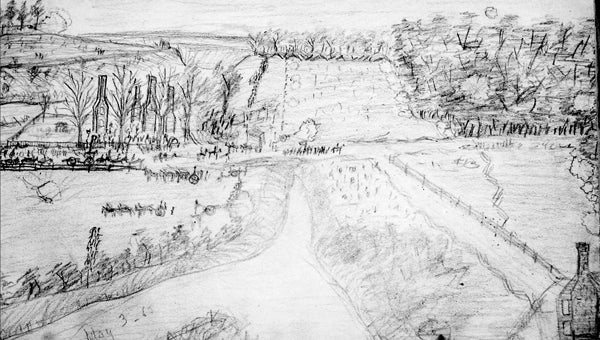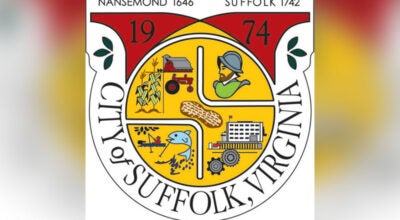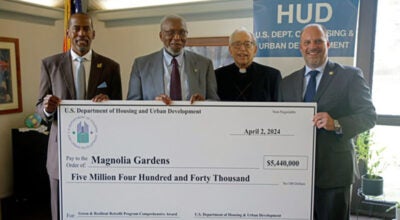Another Costly Day
Published 10:51 pm Thursday, May 2, 2013

This picture, drawn by Corporal Thomas Place of the First New York Mounted Rifles, shows the advance of the Union infantry and artillery along Providence Church Road (now North Main Street) on May 3, 1863. The chimneys on the left are the ruins of Captain Nathaniel Pruden’s house. The Union line runs from top to bottom across the middle of the picture. The puffs of smoke from the woods on the right reveal the hidden Confederate line. (Courtesy of the Virginia Historical Society)
Editor’s Note: To mark its 150th anniversary, through May 4, the Suffolk News-Herald will feature a multi-part series by Suffolk historian Kermit Hobbs detailing the 23-day Siege of Suffolk.
By Kermit Hobbs
Special to the News-Herald
Sunday, May 3, 1863
Part 14: The Battle of Providence Church Road
Three days had passed since Confederate Gen. James Longstreet had received orders to withdraw his force of 20,000 men from Suffolk. By this time, Gen. Joseph Hooker was already battling Gen. Robert E. Lee’s Confederates at Chancellorsville in northern Virginia. Longstreet’s men were desperately needed.
Still, Longstreet had by no means been idle. By the time he had received the command to withdraw, his wagon trains had made their way into North Carolina, still gathering forage for the Confederate army. Bringing out those supplies was the most important mission Longstreet could accomplish during his campaign, and they would have to be safely across the Blackwater River, out of reach of the enemy, before he could begin to move his army.
Only a small number of his officers knew that the actual withdrawal would begin at dark on this evening, Sunday, May 3, 1863.
Gen. John Peck in Suffolk had tested the Confederates’ strength two days before and found the troops still firmly entrenched. But both Peck and his superiors knew Longstreet must have been planning to pull out soon, and they planned an even more aggressive probe to test him.
A three-pronged attack was made on this day. A small force of infantry was put ashore near Chuckatuck and ordered to march to Reed’s Ferry. Another force was landed near Fort Huger with instructions to link up with the first, at Reed’s Ferry. A much larger force would cross the Nansemond River at Suffolk and push up Providence Church Road (now North Main Street), pressing hard against the Confederate line.
At around 9 a.m., four regiments of Union infantry, supported by cavalry and artillery, crossed the Nansemond River on a pontoon bridge on what is now North Main Street. Even as they crossed, Confederate “Minie Balls” and cannon balls whizzed through their midst.
After they crossed, they fanned out into a line of battle and began to move forward. They gradually drove the Confederate pickets back into the woods ahead of them, eventually passing the ruins of Capt. Nathaniel Pruden’s house, across the road from the present Walmart location.
As the hot, sultry day wore on, the Union infantry moved slowly forward, next through an apple orchard.
One New Hampshire soldier observed: “As the enemy’s bullets, and an occasional shell, cut, ripped, and tore through the apple trees, we were showered with apple blossoms as if in a miniature snow storm.”
The main Confederate line was set slightly back in the woods 500 yards ahead of him. That line stretched all the way across the peninsula formed by the Nansemond River, crossing the road at about the location of the present Virginia Department of Transportation offices on North Main Street.
The Union infantry pushed farther until reaching a zig-zag rail fence that offered a bit of cover. They waited in this position for an hour, until the orders finally came to charge the Confederate line across the open field ahead. When the order came, the four regiments raced the last 300-400 yards across the field toward the Rebels.
The Confederate line, as strong as it was, was manned by just two regiments of Alabama infantry and a few pieces of artillery. As the charging Yankees approached, the Confederates retreated to safety back in the woods. Then they rallied and came back upon the exhausted Yankees, who had finally reached their trenches. In the confusion, some of the Union infantry fired upon each other, thinking that they were Confederates.
The Confederates then withdrew to their next line of entrenchments just south of the fork in the road (Elephant’s Fork), while the Union troops awaited orders for their next move. For the next two hours the two sides held positions, with sharpshooters picking off enemy soldiers wherever they could see them and artillery firing back and forth into enemy positions.
It was during this time that Col. Benjamin Ringold of the 103rd New York Infantry was mortally wounded.
Peck’s intention had been to test the strength of the Confederates and, just has he had found two days earlier, they were still present and in force. He sent out a command for the Union forces to withdraw to Suffolk.
The force from Fort Huger had been unable to break out and advance to Reed’s Ferry. The Chuckatuck force had made it to Reed’s Ferry, but not finding the Fort Huger force, moved east to the Nansemond River. There they camped under the protection of the Union gunboats.
The day’s fighting had cost the Union 60 or 70 men in killed and wounded. It had been another costly day.
Tomorrow: Part 15 — The siege is lifted






